
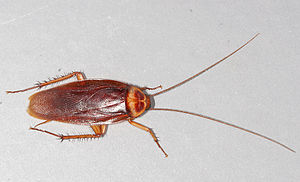
Cockroaches
American cockroaches generally live in moist areas, but can survive in dry areas if they have access to water. They prefer warm temperatures around 29 °C (84 °F) and do not tolerate cold temperatures. In residential areas, these cockroaches live in basements and sewers, and may move outdoors into yards during warm weather. These cockroaches are common in basements, crawl spaces, cracks and crevices of porches, foundations, and walkways adjacent to buildings.
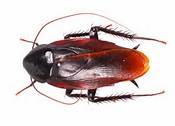
Smokey Brown Cockroach
The smoky brown cockroach is very common in Japan, as well as the southern United States and tropical climates; notably, it can be found in Florida, Louisiana, Mississippi, Texas, and other moist Gulf coastal states, and along the southern Mississippi River.
The smoky brown cockroach prefers warmer climates and is not cold-tolerant. It may, however, be able to survive colder climates by going indoors. In addition to this, it fares well in moist conditions and appears to be particularly prevalent in moist concealed areas. It often lives around the perimeter of buildings.
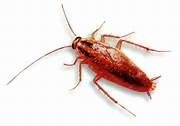
German Cockroach
(Blattella germanica) is a small species of cockroach, measuring about 1.3 to 1.6 cm (0.51 to 0.63 in) long; however, larger individuals have been recorded. It can be tan through brown to almost black, and has two dark parallel streaks running from the head to the base of the wings.
Although it has wings, it is unable to sustain flight. Found throughout many human settlements, these insects are particularly associated with restaurants, food processing facilities, hotels, and nursing homes. In colder climates, they are found only near human habitats, since they are not very tolerant to cold. However, German cockroaches have been found as far north as Alert, Nunavut, and as far south as southern Patagonia.
The German cockroach is originally from Africa. It is very closely related to the Asian cockroach, and to the casual observer they appear nearly identical and may be mistaken for each other (the Asian cockroach, however, is attracted to light and is capable of flight not unlike a moth— not so of the German cockroach). Though nocturnal, this cockroach can be seen in the day occasionally, especially if the population is large or they have been disturbed. However, sightings are most commonly reported in the evening hours, as they are most active at night. This type of cockroach can emit an unpleasant odor when excited or frightened.
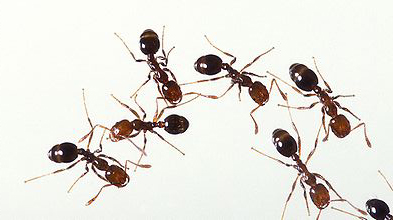
Fire Ant
A typical fire ant colony produces large mounds in open areas, and feeds mostly on young plants, seeds and sometimes crickets. Fire ants often attack small animals and can kill them. Unlike many other ants, which bite and then spray acid on the wound, fire ants bite only to get a grip and then sting (from the abdomen) and inject a toxic alkaloid venom called Solenopsin, a compound from the class of piperidines. For humans, this is a painful sting, a sensation similar to what one feels when burned by fire—hence the name fire ant—and the after effects of the sting can be deadly to sensitive people. The liquid is both insecticidal and antibiotic.
Fire ants nest in the soil, often near moist areas, such as river banks, pond shores, watered lawns and highway shoulder. Usually, the nest will not be visible, as it will be built under objects such as timber, logs, rocks, or bricks. If there is no cover for nesting, dome-shaped mounds will be constructed, but these are usually only found in open spaces, such as fields, parks and lawns. These mounds can reach heights of 40 cm (15.7 in), and can also be as deep as a meter and a half (five feet).
Colonies are founded by small groups of queens or single queens. Even if only one queen survives, within a month or so, the colony can expand to thousands of individuals. Some colonies may be polygynous (having multiple queens per nest).
Striped Bark Scorpion
Habitat, Food Source(s), Damage: Scorpions use the pincers to capture and hold prey. This species occurs under rocks, under boards, and in debris. It can be found indoors or outdoors in a wide variety of habitats (pine forests in East Texas, rocky slopes, grasslands, juniper breaks in other parts of the state).
Centruroides are active foragers and do not burrow. They are considered “bark scorpions” with a distinct association with dead vegetation, fallen logs, and human dwellings. It is common for them to climb, and many reports in homes are associated with attics. Scorpions remain sheltered in the daytime and become active at night. This behavior helps with regulating temperature (thermoregulation) and water balance. Their bodies are covered with a waxy cuticle which also helps reduce water loss. For reasons yet unknown, the scorpion cuticle fluoresces under ultraviolet light i.e., a black light.
Pest Status: Most common and widespread scorpion in Texas; stings are painful and produce local swelling and itching that may persist for several days. Reaction to the bite may vary based on sensitivity of the individual. Non-lethal stings may be mild to strong and produce edema (swelling), discoloration, numbness, and pain which may last for several minutes to several days. Deaths attributed to this species are not well substantiated. There are no scorpions in Texas that are considered lethal to man.
Roof Rat
Roof rats are more aerial than Norway rats in their habitat selection and often live in trees or on vine-covered fences. Landscaped residential or industrial areas provide good habitat, as does riparian vegetation of riverbanks and streams. Parks with natural and artificial ponds, or reservoirs may also be infested. Roof rats will often move into sugarcane and citrus groves. They are sometimes found living in rice fields or around poultry or other farm buildings as well as in industrial sites where food and shelter are available.
Roof rats frequently enter buildings from the roof or from accesses near overhead utility lines, which they use to travel from area to area. They are often found living on the second floor of a warehouse in which Norway rats occupy the first or basement floor. Once established, they readily breed and thrive within buildings, just as Norway rats do. They have also been found living in sewer systems, but this is not common.
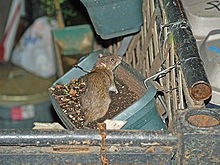
Norway Rat
Likely originating from the plains of Asia, northern China and Mongolia, the brown or Norway rat spread to other parts of the world sometime in the Middle Ages. The question of when brown rats became commensal with humans remains unsettled, but as a species, they have spread and established themselves along routes of human migration and now live almost everywhere humans are.
The brown rat may have been present in Europe as early as 1553, a conclusion drawn from an illustration and description by Swiss naturalist Conrad Gesner in his book Historiae animalium, published 1551–1558. Though Gesner’s description could apply to the black, his mention of a large percentage of albino specimens—not uncommon among wild populations of brown rats—adds credibility to this conclusion.
Reliable reports dating to the 18th century document the presence of the brown rat in Ireland in 1722, England in 1730, France in 1735, Germany in 1750, and Spain in 1800, becoming widespread during the Industrial Revolution. It did not reach North America until around 1750–1755.
As it spread from Asia, the brown rat generally displaced the black rat in areas where humans lived. In addition to being larger and more aggressive, the change from wooden structures and thatched roofs to bricked and tiled buildings favored the burrowing brown rats over the arboreal black rats. In addition, brown rats eat a wider variety of foods, and are more resistant to weather extremes.
In the absence of humans, brown rats prefer damp environments, such as river banks. However, the great majority are now linked to man-made environments, such as sewage systems.
It is often said that there are as many rats in cities as people, but this varies from area to area depending on climate, living conditions, etc. Brown rats in cities tend not to wander extensively, often staying within 20 m (66 ft.) of their nest if a suitable concentrated food supply is available, but they will range more widely where food availability is lower. There is great debate over the size of the population of rats in New York City, with estimates from almost 100 million rats to as few as 250,000. Experts suggest New York is a particularly attractive place for rats because of its aging infrastructure, high moisture and poverty rates. In addition to sewers, rats are very comfortable living in alleyways and residential buildings, as there is usually a large and continuous food source in those areas.
In the United Kingdom, some figures show the rat population has been rising, with estimations that 81 million rats reside in the UK. Those figures would mean there are 1.3 rats per person in the country. High rat populations in the UK are often attributed to the mild climate, which allow them higher survival rates during the winter months.
The only brown rat-free zones in the world are the Arctic, the Antarctic, some especially isolated islands, such as Iceland, the province of Alberta in Canada, and certain conservation areas in New Zealand.
Antarctica is almost completely covered by ice and has no permanent human inhabitants, making it uninhabitable by rats. The Arctic has extremely cold winters that rats cannot survive outdoors, and the human population density is extremely low, making it difficult for rats to travel from one habitation to another. When the occasional rat infestation is noticed and eliminated, the rats are unable to re-infest it from an adjacent one. Isolated islands are also able to eliminate rat populations because of low human population density and geographic distance from other rat populations.
House Mouse
House mice have an adult body length (nose to base of tail) of 7.5–10 cm (3.0–3.9 in) and a tail length of 5–10 cm (2.0–3.9 in). The weight is typically 10–25 g (0.4–0.9 oz.). In the wild they vary in color from light to dark agouti (light to dark brown) but domesticated fancy mice and laboratory mice are produced in many colors ranging from white to champagne to black. They have short hair and some, but not all, sub-species have a light belly. The ears and tail have little hair. The hind feet are short compared to Apodemus mice, only 15–19 mm (0.59–0.75 in) long; the normal gait is a run with a stride of about 4.5 cm (1.8 in), though they can jump vertically up to 45 cm (18 in). The voice is a high-pitched squeak. House mice thrive under a variety of conditions: they are found in and around homes and commercial structures, as well as in open fields and agricultural lands.
New-born males and females can be distinguished on close examination as the anogenital distance in males is approximately double that of the female. From the age of about 10 days females have five pairs of mammary glands and nipples; males have no nipples. When sexually mature, the most striking and obvious difference is the presence of testicles on the males. These are large compared to the rest of the body and can be retracted into the body.
The tail, which is used for balance, has only a thin covering of hair as it is the main peripheral organ of heat loss in thermoregulation along with — to a lesser extent — the hairless parts of the paws and ears.
Blood flow to the tail can be precisely controlled in response to changes in ambient temperature using a system of arteriovenous anastomoses to increase the temperature of the skin on the tail by as much as 10°C to lose body heat. Tail length varies according to the environmental temperature of the mouse during post-natal development and so mice living in colder regions tend to have shorter tails. The tail is also used for balance when the mouse is climbing or running, or as a base when the animal stands on its hind legs (a behavior known as “tripoding”), and to convey information about the dominance status of an individual in encounters with other mice.
In addition to the regular pea-size thymus organ in the chest, house mice have a second functional pinhead-size thymus organ in the neck next to the trachea.
Termites
Along with Reticulitermes virginica, R. flavipes is responsible for 80% of the $2.2 billion spent annually in the United States on termite control. Termites feed on wood cellulose, meaning that their presence in human made structures often goes unnoticed for lengthy periods of time. A termite infested timber will appear structurally sound from the outside, while inside it will have a honeycombed appearance. To detect the presence of R. flavipes the observer can test the integrity of the wood by tapping it with a screwdriver. If present, R. flavipes is found at, near or below ground level. Trim work, sub flooring, flooring, and the structural timbers are the areas of a building most susceptible to termite damage. The Eastern subterranean termite is considered a serious economic timber pest and it is estimated that in high activity areas more than 1 in 5 homes have been or will be attacked.
Termite control methods include: physical barriers, chemical treatments, baits and physical treatments (such as heat, freezing, electrocution and microwave irradiation).
Structural damage to buildings is not R. flavipes’ only impact on humans. Termites also play a critical role in the decomposition of organic matter in natural communities. Without termites, the accumulation of dead organic matter on the forest floor would become detrimental to integrity of that forest. The benefits provided by R. flavipes in terms of their contribution to environmental regulation may far outweigh the disadvantages they pose.
Fleas
The cat flea is a small, sucking, insect of the order Siphonoptera. Adults range from 1–2 mm long and are usually a reddish-brown color, although this can vary. The cat flea, and all other fleas, are compressed laterally, resulting in an extremely thin insect that can be quite hard to find in an animal’s coat.
The cat flea’s primary host is the domestic cat, but the cat flea is also the primary flea infesting dogs in most of the world. The cat flea can also maintain its life cycle on other carnivores and on omnivores.
Humans can be bitten, though a long-term population of cat fleas cannot be sustained and infest people. However, if the female flea is allowed to feed for twelve consecutive hours on a human, it can lay viable eggs.
Life Cycle

Photo showing some characteristics used to identify from other fleas, including genal comb.
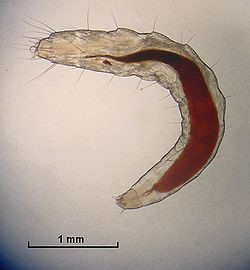
Flea larva showing red ingested blood.
Fleas go through four life cycle stages of egg, larva, pupa, and imago (adult). Adult fleas must feed on blood before they can become capable of reproduction.
Flea populations are evenly distributed, with about 50% eggs, 35% larvae, 10% pupae, and 5% adults.
Eggs
The female flea lays her eggs on the host. The eggs, once dry, have evolved to filter out of the hair coat of the animal, and into the resting and sheltering area of the animal.
Larva
The eggs hatch into larvae, which are negatively phototaxic, meaning that they hide from light in the substrate. Flea larvae feed on a variety of organic substances, but most importantly subsist on dried blood that is filtered out of the hair coat of the host after it is deposited there as adult flea fecal material. Thus the adult population on the animal feeds the larval population in the animal’s environment.
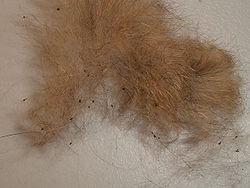
Flea fecal material, coiled larva and fleas in the pupae combed from a cat, is also called flea dirt.
Pupal stage
Flea larvae metamorphose through 4 stages before spinning a cocoon and entering the pupal stage. The pupal stage varies greatly in length; the pre-emergent flea does not normally emerge as a young adult flea until the presence of a potential host is perceived by warmth or vibration.
Fleas
Newly emerged fleas jump to a new host within seconds of emerging from the cocoon. The new flea begins feeding on host blood within minutes.
